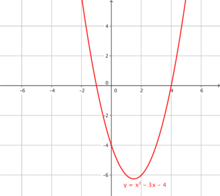Quadratic function

In algebra, Quadratic function is function that contains an expression where its degree (the highest exponent it has) is 2, which means that it is quadratic (See etymology). Its single-variable standard form isː
Where , and are all constants and ≠ 0.
When such a function gets plotted on a graph where , a curve that extends infinitely called a parabola will appear.
When a quadratic function is set equal to zero, then it turns into a quadratic equation. The answers to the equation are where the function crosses the -axis.
Etymology[change | change source]
The word quadratic comes from the Latin word quadrātum ("square"). This is because of the presence of a number (which is in the standard form) that is the result of squaring its square root ().








